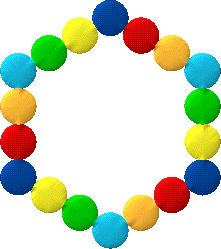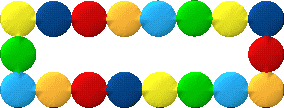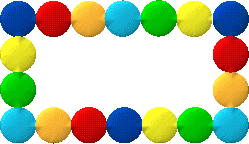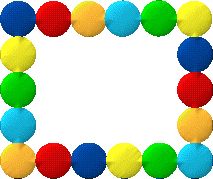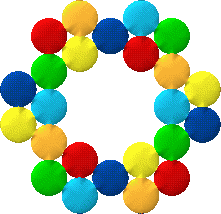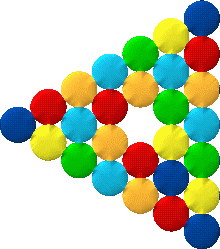Copyright © University of Cambridge. All rights reserved.
Bracelets
Well, in this country, and perhaps in yours, lots of young folk are wearing bracelets - both girls and boys. I was looking at some that my students wear and found that some were magnetic!
Many seem to have beads that are spherical and they go around the wrist quite comfortably. There are lots of different sizes and some have large beads and some quite small beads.
I suppose that most wrists are kind of oval - squashed circles - in shape and with the string or wire through the beads they fit very well.
It was playing with the magnetic beads off the person's wrist that gave me some ideas. There were $18$ beads altogether and they were all the same colour but I've chosen to show them in a variety of colours!
I found I could put them into different shapes:-
mind you, you'd have to have a triangular wrist for them to stay like that!
Now suppose we play around with this idea and make a rule that there has to be some shaped hole in the middle for a wrist. But we'll allow that to be all kinds of shapes :- vaguely triangular, rectangular, hexagonal etc.
You could try this out with marbles, circular counters, tiddly-winks, coins or with a drawing program on your computer.
I think we'll make a rule that the circles/spheres have to be the same size and you don't have to imagine that they're magnetic!
So here are some that I found with $18$ beads:-
I liked that one as it is the longest rectangle you could make - remembering to keep a wrist-hole. I then went on to:-
and then, almost a square :-
I like the next one - although it was a little hard to do on the computer!
Have a go at making these with your circles!
Well, now it's time to explore, to see what other bracelets you can make. Remember that there's to be a "wrist-hole". The shapes should be kind of "regular" but not strictly so, because then we could not use rectangles.
Other things to investigate:-
- If you make a particular shape with $18$ and then the next size up comes when you use $24$, is there going to be the next size up at $30$?
So whatever shape you make, how many will you need to make the next size up? How does each shape grow? Look at the first shape I made using $24$:-
What will the next size up of this look like?
- What are good numbers of beads to use? Why?
- What's the smallest number of beads that will allow you to make two identical bracelets? Why? How many will you need to make three of those?
-
If you make a bracelet with just one thickness of beads them how many will you need to make one that has a double thickness? Here's one I did by making the wrist-hole smaller and getting it to be twice as thick:
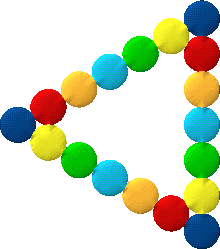
- Would cube beads lend themselves to exploring slightly differently? What about tetrahedral bead?
- What about ...?
Why do this problem?
This activity is good for engaging pupils in number patterns, symmetry, factors, multiples, algebra and shape work, and allows them to be creative. It should also encourage pupils to persevere for a longer period of time than perhaps is usual.
Possible approach
This is best introduced by physically looking at bracelets made of beads and asking the pupils to talk about what they notice.
Beware that when children are counting or communicating generally about what they've done there is a tendency to count the number on each side of a shape inaccurately. In this example:
... there is the confusion of counting $4$ on each side and then multiplying by $6$, instead of counting the "new ones" each time and saying that there are $3$ new ones on each side.
Having dotty square and triangular paper available may help the children. Just let them enjoy this and see what opportunities arise!
Key questions
Tell me about the shapes you've made.
How many beads would you need for the next size up/down?
Possible extension
Simply asking the question "I wonder what would happen if we ...?" will encourage learners to take the activity in new directions.
Possible support
Any practical resources will help the majority of pupils, although some may like to construct them on a computer while others may prefer to draw their bracelets. I found old fashioned curtain rings to be really good but I guess that coins would also be useful!
